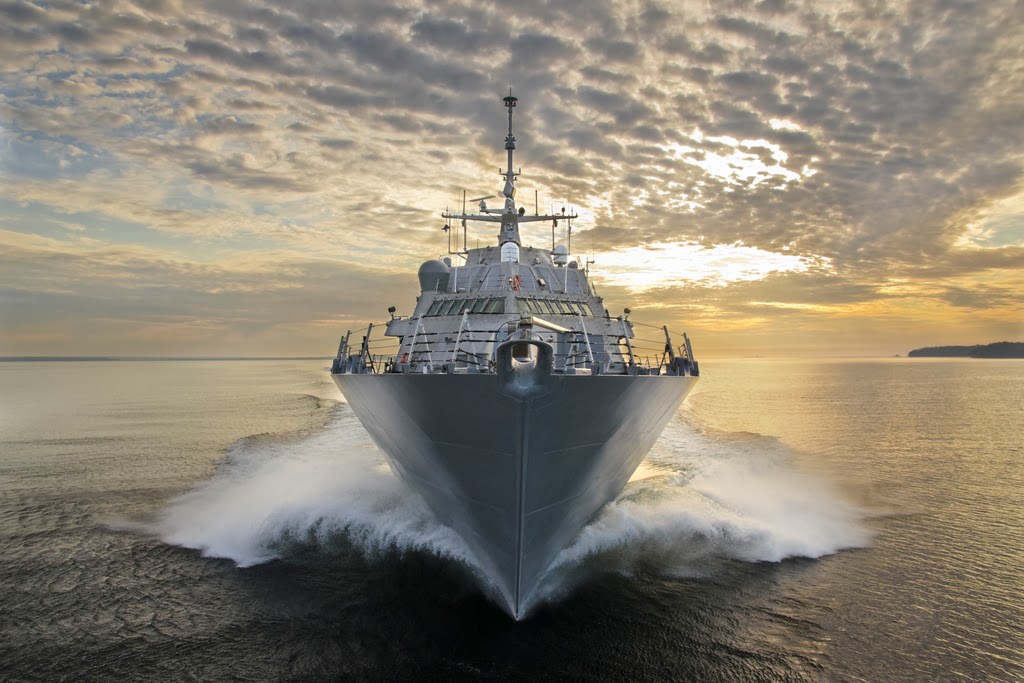He provides an excellent overview of the challenges faced in the LCS program and status to date. To obtain the full article, you'll need to become a member of the Naval Institute, (I highly recommend the $49 investment in the annual membership fee!) Click here to read a short authorized summary from the usni.org.
Let me offer up some comments on this excellent article:
RADM Rodwen comments:
Three points must be made up front.
First, the LCS was conceptualized nearly a decade ago to address
warfighting capability gaps that still exist today: littoral surface warfare
(SUW), littoral antisubmarine warfare (ASW), and mine countermeasures (MCM).
Second, LCS remains the most economical available ship to address these gaps
while providing global forward presence. Finally, we have very little
experience with modularity and how to man, train, equip, maintain, modernize,
sustain, and tactically employ this ship. The Navy is incorporating lessons
learned with a sober sense of the necessary cultural, organizational, and
operational changes required to ensure that LCS is successful.
The LCS program has faced many challenges since conceived and the first two ships were designed and built under competitive contracts. But with Friday's deployment of USS FREEDOM (LCS 1), the Navy has achieved an important milestone on adding this highly effective warship to our fleet. Although still in "development" as far as crew size, modular war-fighting packages and operational experience, the dedication of the Navy leadership, contractor teams and the Blue and Gold Crews of all LCS ships is to be greatly admired.Other key points from his article:
First and foremost, LCS is a warship. Our emphasis today is on ensuring LCS’s successful Fleet introduction and performing those three previously mentioned warfare missions proficiently in a hostile environment. The ships have remained consistent with our original assessments and recurring analysis of the warfighting requirements of today and tomorrow. The ship attributes and capabilities include:
Speed and Endurance: The ship would have to be quick and agile with
low speeds for most mission operations, economical speeds for transits, and
high-sprint speeds of 40–50 knots. High-sprint speeds were desirable for
responsive mobility, increased search volume, and threat evasion. Navy leaders
were willing to trade endurance to achieve those speeds.
Unmanned Systems and Modularity: LCS was envisioned to employ a variety of
manned and unmanned surface, air, and undersea vehicles capable of real-time
data exchange. Its modular mission remains the heart and key strength of the LCS
concept.
Mid-life combat-system upgrades necessary to
pace evolving threats are usually intensive and expensive. LCS’s open
architecture (OA) combat system and modular design allow for accelerated,
comparatively cost-effective, noninvasive retrofit and upgrades, and the
incorporation of emerging technologies over the course of the ships’ 25-year
expected service lives.
Self-Defense and Survivability: LCS is envisioned to operate independently,
with a surface-action group, or in support of a carrier/expeditionary strike
group. It will operate with other ships in higher threat situations, relying on
the anti-air warfare capabilities of other Fleet assets with the ship’s
survivability characteristics linked to self-preservation as opposed to continued
warfighting.
Cost: Affordability was a primary programmatic concern for LCS. In
2002, the Navy was struggling to contain shipbuilding cost growth. Therefore,
both the Office of the Secretary of Defense (OSD) and leaders wanted LCS to be
a low-cost ship built in numbers. OSD expected the Department of the Navy to
buy at least three missionized LCSs for the price of one Arleigh Burke –class
destroyer, equating to a target cost of approximately $400 million per ship,
including mission packages (in Fiscal Year 2005 dollars), whereas the Navy
wanted $250 million per ship without a mission package. 3 A “threshold” cost of $400 million and
an “objective” cost of $250 million presented significant challenges to the
requirements community and industry teams.
His article concludes with the following observations:
We envision two or three LCSs operating with carrier strike groups or amphibious ready groups. For example, if we have three LCSs in the Persian Gulf in addition to three DDGs from a strike group, the DDGs can fulfill other critical missions, including ballistic-missile defense, intelligence collection, and air defense. Meanwhile, one SUW mission package-capable LCS conducts anti-piracy patrols, a second MCM mission package-capable LCS surveys Q-routes in the Strait of Hormuz, and a third LCS conducts patrols in the International Recognized Transit Corridor. 6
In short, the LCS is essential to filling the
warfighting gaps in the littorals. This ship has a very clear purpose—to
fulfill defined, enduring, and Joint Requirements Oversight Council-approved
warfighting gaps. Concurrently, fiscal realities dictate that we need LCS
because it is a cost-effective and capable solution. The Navy is proceeding
responsibly and enthusiastically in putting these ships to sea rapidly to meet
our requirements around the world. Combatant commanders are eager for this
addition to the joint force, and leadership remains committed to the success of
this program. We are regaining our track at full speed and will continue to
refine our course as appropriate to meet the Navy’s operational needs.
I encourage you to become a member of the U.S. Naval Institute, as well the the Navy League of the United States. Both are excellent organizations and will add to your ability to support our young men and women of the United States Navy who serve our nation and protect our freedoms.


No comments:
Post a Comment